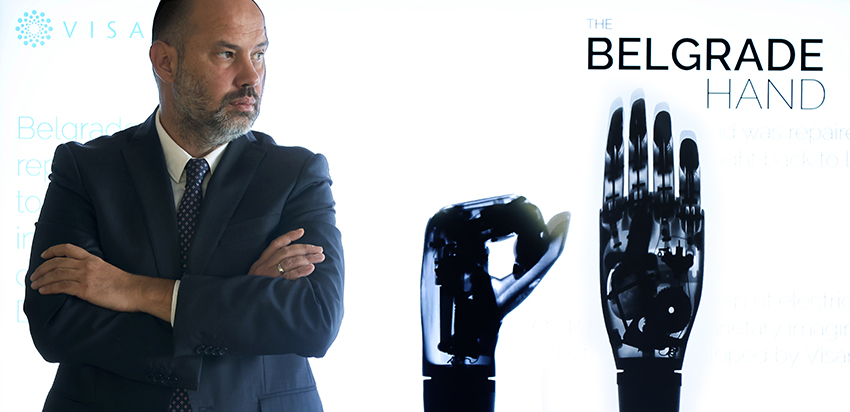12 Oct 20 years of Visaris – Interview with Marko Petrović, Director of Visaris: “Proud of more than 2,000 satisfied users of Visaris technology.”
 BELGRADE, 12th OCTOBER 2023.
BELGRADE, 12th OCTOBER 2023.
After 20 years since the first domestic digital X-ray, when you look back at the beginnings and where the company is now, how do you view the journey you’ve taken, how much has the company changed and developed, and what would you highlight as the greatest achievements?
When we started from scratch in 2003, the idea was to become a software company for digital signal processing in radiology. With Jugorendgen from Niš, we formed a joint company, and already in 2004, we installed our first digital X-ray at the IOHR Banjica. This was the first device of its kind in Serbia and also the first Serbian digital X-ray. Unfortunately, in 2005, Jugorendgen went bankrupt, and we were left with the colossal task of investing in the development of all the mechanical and electromechanical parts of the X-ray machine from scratch. With a very limited family budget, we managed to compensate for the loss of a major partner and became one of the few independent companies in this high-tech field worldwide. Today, after 20 years, we are proud to have more than 2,000 satisfied users of Visaris technology. We have also managed to retain the original team of engineers and programmers around whom a new generation of scientists is now gathered, working tirelessly on new technologies that will solidify Visaris as an industrial innovator.
How much presence do X-ray machines from Serbia have in the international market, and how do they compare to foreign manufacturers?
Through a network of partners and distributors, we are present in over 40 countries worldwide. Our X-ray machines belong to the category of high-performance machines that meet the highest standards of university clinics and demanding specialized and emergency centers in city hospitals with a high patient flow and a wide range of examinations. Technologically, we do not lag behind market leaders and successfully secure contracts in the most demanding global markets in fierce competition. We are proud to represent Serbia in this field, as we believe that our victories pave the way for other Serbian companies.
How is a high-tech company in the field of X-rays from Serbia perceived in the international market? In which countries are you present, and in which institutions?
The field in which we operate is technology-based and highly specialized, so all manufacturers are well-acquainted with each other. We are perceived as an innovative and technical company, which means that our Serbian origin is not a decisive factor. Our technical director and technology creator, Vladimir Petrović, has been a prominent scientist in the field of digital signal processing for more than 25 years and is a professor at the University of Manchester and the Faculty of Technical Sciences (FTN) in Novi Sad. Besides Vladimir, in a team of about 80 people, we have a significant number of professionals with extensive experience in international business and working in multinational companies, so it’s not surprising that we have succeeded in breaking into the global market. The largest individual markets are the USA, Italy, and Australia, but we are also present in most EU countries, as well as exotic markets like Pakistan, South Africa, Taiwan, and others.
You have established cooperation with domestic and foreign faculties and institutes. In which direction are scientific research and the latest developments in this field moving?
Digital technology is becoming increasingly accessible, and there is expected to be a significant acceleration in data collection, enabling applicable machine learning aimed at helping doctors detect shapes and changes that are too small for the human eye and reducing room for errors. In this sense, Visaris is already part of the global scientific community where we participate in a European Union project, Incisive, which includes over 20 European universities and aims to develop software for early cancer detection on different diagnostic equipment modalities. In Serbia, we collaborate with the Faculty of Electrical Engineering and FTN.
What is the future of X-rays, and what is expected, and more importantly, what will be the practical application in healthcare?
X-rays are a fundamental diagnostic tool, accounting for 75% of all radiological examinations. In the future, X-ray cabinets will be equipped with state-of-the-art digital devices that have applications for artificial intelligence (AI) and will be able to detect unwanted changes during routine or systematic examinations. The logic is that by using AI applications on such primary devices, we can help patients and doctors identify problems in the early stages.
What are the needs of healthcare institutions in Serbia, and how equipped are healthcare institutions with digital X-ray devices? How does this compare to the rest of the world?
Healthcare institutions in Serbia are relatively well-equipped, considering certain inconsistencies. Unfortunately, almost half the world is still in an analog format, even though, for example, you won’t find a country today that still uses analog cameras. The transition in X-rays takes longer because the investments in this equipment are more substantial. The Western world is ahead in this transition, of course, compared to the rest of the developing countries. By entering the market, we believe that we have helped Serbia become one of the leading countries in this field, as we have skipped equipment for indirect digitalization and immediately transitioned to digital technology.
We saw during the COVID-19 pandemic how important it was to be adequately equipped with modern medical tools and equipment. How did your company react in that crisis situation?
The situation during the COVID-19 pandemic was incredible from multiple aspects. Given that lung infection was the primary indication of the disease, the demand for this equipment far exceeded the production capacities of just over a dozen countries in the first few months of the pandemic. Such a dramatic disruption in the market created panic because most countries were caught unprepared and couldn’t meet their needs within the short timeframes required. Manufacturers like us primarily prioritized domestic markets, while the remaining capacity was committed to exports. It’s important to note that Visaris made a decision at the early stage of the pandemic not to raise prices but to focus on maximizing production volume. Thanks to the exceptional dedication of our employees, we worked in three shifts for almost two years and successfully met the needs of Serbia and all our clients worldwide at that time.
What are Visaris’ future plans?
Investing in the further development of new products for dynamic imaging, as well as artificial intelligence (AI) technology, is the top priority for our company. We also continue to expand into new markets and grow the Visaris family of international partners. Starting in 2024, we plan to invest in key markets through the acquisition of foreign companies for the first time. By acquiring partner or competitive firms, we expect to accelerate the growth and availability of our technology. However, more important than all of the above is that we anticipate a significant expansion of our team with new talents who are expected to bring new strength and vitality to the already mature and experienced professionals at Visaris.



